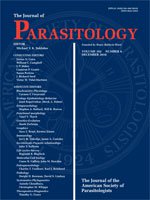Baylisascaris procyonis is a nematode whose definitive host is the raccoon (Procyon lotor). Adult parasites are not particularly pathogenic to raccoons; however, larvae in intermediate hosts can cause visceral, ocular, and neural larva migrans. Humans serve as dead-end hosts, and pathological responses are similar to those found in infected intermediate hosts. Infected raccoons expose intermediate hosts through their feces, which can contain millions of B. procyonis eggs. Our objective was to determine how the quantity and viability of B. procyonis eggs in soil changed over time within different soil texture, moisture, and sun exposure. To examine egg survival and movement through soil we placed 100 B. procyonis eggs on 100 squares in 48 boxes representing a full factorial treatment of soil texture, moisture, and sun level. We monitored egg percolation and survival for 2 yr, removing (at 0, 1, 3, 6, 12, 18, and 24 mo) 5 squares from each box and counting the number of viable eggs at each depth in the soil column. Dry soils were mainly impermeable; even after 2 yr, >60% of B. procyonis eggs remained on the surface of all soil textures. Wet soils were more permeable than dry soils, but even in wet sandy soils where the greatest egg movement occurred, it required 1 yr before 60% of eggs transitioned from the soil surface to the next soil depth. For all soil textures, moistures, sun exposures, and depths, >92% of B. procyonis eggs remained viable after 2 yr in the southern Texas environment. Therefore, high exposure risk exists for potential hosts because B. procyonis eggs remain viable on or near the soil surface for at least 2 yr.
How to translate text using browser tools
1 December 2016
Permeability and Viability of Baylisascaris procyonis Eggs in Southern Texas Soils
Jacob L. Ogdee,
Scott E. Henke,
David B. Wester,
Alan M. Fedynich
ACCESS THE FULL ARTICLE

Journal of Parasitology
Vol. 102 • No. 6
December 2016
Vol. 102 • No. 6
December 2016




